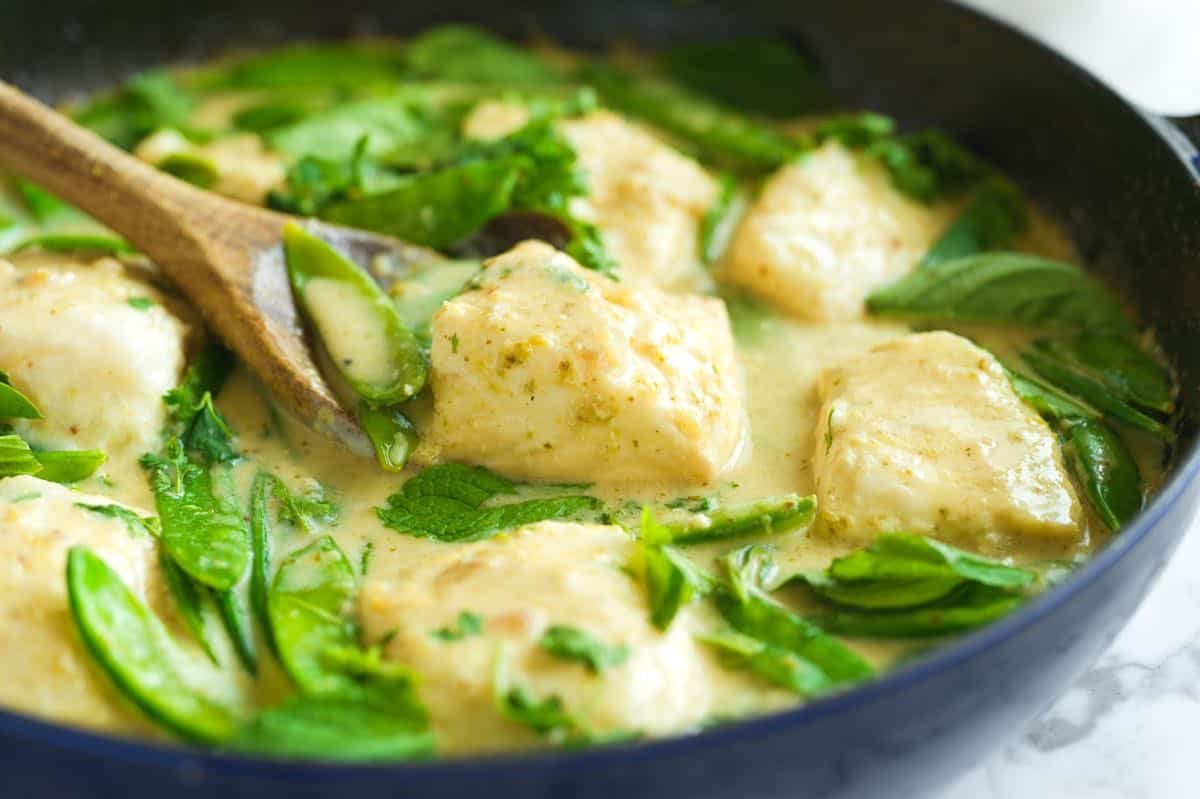This incredibly flavorful Thai fish curry recipe with flaky white fish, coconut milk, and green curry paste is pure magic. We’ve been exploring the world of Thai curries, and this one is a winner.
If you’ve been following along, you know we’ve been obsessed with our homemade green curry paste. We have already shared our Thai Green Curry with chicken, but we loved the flavor so much, we had to find another way to use it, and this Thai-inspired fish curry was the answer. It’s everything we hoped for and more.
It’s also really easy to make (I promise!). This saucy green curry fish is perfect for when you’re craving a light, flavorful meal, but you don’t have much time. You’ll gently simmer flaky white fish in a vibrant, aromatic coconut sauce. Then, serve the fish and lots of the creamy green curry sauce over Jasmine rice or rice noodles.
Key Ingredients
White Fish: Choose a flaky white fish for this fish curry. Think cod, halibut, haddock, tilapia, and snapper for a tender, soft texture. Or, go with mahi mahi or sea bass for a slightly firmer texture.
Green Curry Paste: I love using our homemade curry paste, which is bright and super herby thanks to chile peppers, garlic, lemongrass, ginger, mint, and basil. With our recipe, you have complete control over the spice level, which is a big bonus. Of course, you can still use a store-bought Thai curry paste. My favorite is from Maesri (sold in cans).
Coconut Milk: This is a non-negotiable for a creamy curry, and full-fat coconut milk really is best. A quick tip when you’re shopping: give the can a shake. If it sounds liquidy, skip it. A can that’s not as liquidy has more of that delicious thick coconut cream inside!
Fish Sauce: This helps to season the curry. I have two favorites in my pantry, including Red Boat and Three Crabs fish sauce.
Vegetables: I always start by cooking some sliced shallots, and then finish the curry with a quick-cooking veggie like snow peas. Zucchini, snap peas, green beans, spinach, asparagus, or small broccoli florets are also great options.
Lime and Fresh Herbs: To build off the fresh, herby flavor of the curry paste, I love finishing the curry with a squeeze of fresh lime juice and a handful of fresh herbs like Thai basil and mint (Italian basil works, too).
Kaffir Lime Leaves (Optional): These are optional, but they add a lovely aromatic flavor to this curry recipe. They used to be sold in my local grocery store, but they have been harder to find recently. You can buy them online, though! If you do find them fresh, buy a bunch, then freeze them!
Find the full recipe with measurements below.
Tips for Making the Best Thai Fish Curry
We’re head over heels for this recipe, and honestly, I think you will be, too. It’s perfect for an easy weeknight dinner, and doubles as a celebration-worthy dish any time of the year. Here are a few tips for making it:
Tip 1: Boost store-bought paste: If you aren’t starting with our homemade green curry paste, you can boost the flavor of store-bought. Store-bought curry pastes range in flavor and spice level. I recommend Maesri (sold in cans). To achieve the fresh, vibrant flavor that homemade paste gives our curry, add the following along with the curry paste in step two of the recipe below: 2 teaspoons minced garlic, 2 teaspoons finely grated fresh ginger, and 2 teaspoons lemongrass paste.
Tip 2: Cook your curry paste first: Before adding the coconut milk, sauté your curry paste in some oil to bring out the flavors. I do this over medium heat and cook the paste until the color deepens a little, and it just begins to stick to the pan. This step makes a huge difference!

Tip 3: Prepare for some spice: Note! Green curry is supposed to be SPICY. It’s generally the hottest of all the Thai curries. If you are not interested in a spicy dish, you can make our homemade paste and reduce the chili peppers. Or, swap the green curry paste for yellow curry paste, which is much milder and sweeter.
Tip 4: Don’t forget the rice: This fish curry is extra saucy, so you’ll want a bed of rice or noodles to soak up all the creamy coconut sauce. Jasmine rice, brown rice, coconut rice, cilantro lime rice, or cooked rice noodles are perfect. If you’re trying to keep the carbs down, consider my favorite cauliflower rice.
For more Thai curry inspiration, see our homemade red curry paste, which we used for this easy vegetable curry. Or, for a mild curry, see our homemade yellow curry paste, which we use for this yellow chicken curry. Happy cooking!

Thai Fish Curry Recipe
PREP
10 mins
COOK
20 mins
TOTAL
30 mins
This Thai fish curry is perfect for an easy weeknight dinner. We love this from scratch curry paste, but check our tips section below the recipe for ways to boost the flavor of store-bought curry paste.
A quick note on the spice level: traditional green curry is usually quite hot. Our homemade paste is easy to adjust, but be aware that the spice level of store-bought versions will vary. If you’re looking for a good store-bought option, I highly recommend Maesri (sold in cans).
Serve this curry over steamed Jasmine rice, cilantro lime rice, or cooked rice noodles. It’s also amazing with some crispy fried shallots sprinkled over the top!
4 to 6 Servings
You Will Need
2 tablespoons avocado oil
2 medium shallots, sliced thin
6 tablespoons homemade green curry paste (see tips below for using store-bought curry paste)
1 (15oz) can full-fat coconut milk
1 tablespoon fish sauce
4 kaffir lime leaves, optional
1 ½ pounds skinless, boneless white fish, cut into chunks (680g)
8 ounces snow peas (225g)
Juice from half a lime, plus lime wedges for serving
½ cup green herbs like Thai basil, mint, and cilantro for serving
Thinly sliced red chilies for serving, optional
Directions
1Cook the shallots: Heat a wide pot or deep skillet over medium heat. Add the avocado oil and shallots, then cook, stirring them around the pot, until translucent, about 4 minutes.
2Bloom the curry paste: Add the green curry paste and cook, stirring it around, until slightly darker and beginning to stick to the pot, 2 to 3 minutes.
3Simmer the sauce: Pour in the coconut milk, then swirl about 1 cup of water in the empty can to get any remaining coconut milk, and pour the water into the pot. Scrape any stuck bits from the bottom, then stir in the fish sauce. Add the kaffir lime leaves (optional). Simmer until the sauce thickens slightly, 5 to 6 minutes.
4Cook the fish and veggies: Add the fish and snow peas, then simmer until the fish is cooked through and flakes easily with a fork, 5 to 8 minutes. As they cook, spoon the coconut sauce over the fish and vegetables. If most of the fish is tender, but the very tops of the fish are still undercooked, turn the heat off, and cover the pot with a lid for a few minutes so they finish cooking.
5Finish and serve: Turn off the heat, remove the lime leaves, and stir in the lime juice. Taste and season with more fish sauce as needed. Serve over rice, topped with fresh herbs and thinly sliced red chiles (optional).
Adam and Joanne’s Tips
Making store-bought curry paste better: Add the following ingredients along with the curry paste in step two: 2 teaspoons minced garlic, 2 teaspoons finely grated fresh ginger, and 2 teaspoons lemongrass paste. I buy lemongrass paste in tubes. To learn how to make lemongrass paste from fresh, see the tips section of our green curry paste recipe.
Recipe inspired by our Thai Green Curry and Ali Sagle’s Corn and Cod Green Curry (NYT).
The nutrition facts provided are estimates.
Nutrition Per Serving
Serving Size
1/6 of the recipe
/
Calories
274
/
Total Fat
17g
/
Saturated Fat
11.3g
/
Cholesterol
52.2mg
/
Sodium
718.5mg
/
Carbohydrate
8.4g
/
Dietary Fiber
2.1g
/
Total Sugars
2.9g
/
Protein
23.3g




